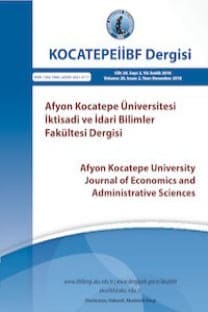MALİ ŞOKLARIN MAKROEKONOMİK DEĞİŞKENLER ÜZERİNDEKİ ETKİLERİ
Mali Şoklar, VAR, yinelemeli yaklaşım
MALİ ŞOKLARIN MAKROEKONOMİK DEĞİŞKENLER ÜZERİNDEKİ ETKİLERİ
___
- ARIN, P.K. and KORAY, F. (2006). Are some taxes different than others?. An empirical investigation of the effects of tax policy in Canada. Empirical Economics, 31(1), 183–193.
- BERUMENT, H. (2003). Treasury auction interest rates and economic performance in Turkey. Mimeo.
- BERUMENT, H. AND DOĞAN, B. (2004). The asymmetric effects of government spending shocks: empirical evidence from Turkey. Journal of Economic and Social Research, 6 (1), 33-51.
- BILBIIE, F., MEIER, A. and MÜLLER, G. J. (2008). What accounts for the changes in U.S. fiscal policy transmission? Journal of Money Credit and Banking, 40 (7), 1439–1470.
- BLANCHARD, O.J. and PEROTTI, R. (2002). An Empirical characterization of the dynamic effects of changes in government spending and taxes on output. The Quarterly Journal of Economics, 117 (4), 1329-1368.
- BURNSIDE, C., EICHENBAUM, M. and FISHER, J. (2004). Fiscal shocks and their consequences. Journal of Economic Theory, 115 (1), 89–117.
- CALDARA, D. and KAMPS, C. (2008). What are the effects of fiscal policy shocks? A VAR based comparative analysis. European Central Bank Working Paper 877 (March).
- ÇEBI, C. (2010). The effects of fiscal policy shocks on output in Turkey: SVAR analysis. İktisat, İşletme ve Finans, 25 (290), 9-34.
- DE CASTRO, F. (2003). Non-Keynesian effects of public expenditure in Spain, Applied Economics Letters, 10 (10), 651-655.
- DE CASTRO, F. (2006). The macroeconomic effects of fiscal policy in Spain, Applied Economics, 38 (8), 913-924.
- DE CASTRO, F. and DE COS, P. (2008). The economic effects of fiscal policy: the case of Spain. Journal of Macroeconomics, 30 (3), 1005–1028.
- EDELBERG, W., EICHENBAUM, M. and FISHER, J. (1999). Understanding the effects of shocks to government purchases. Review of Economic Dynamics 2, 166–206.
- EICHENBAUM, M. and FISHER, J. (2005). Fiscal policy in the aftermath of 9/11. Journal of Money, Credit, and Banking. 37 (1), 1-22.
- ERKAM, S. (2010). Maliye Politikalarının Etkinliği: Teori ve Bir Uygulama. T.C. Maliye Bakanlığı Strateji ve Geliştirme Başkanlığı, No:2010/404.
- FATÁS, A. ve MIHOV, I. (2001). The Effects of fiscal policy on consumption and employment: theory and evidence. CEPR Discussion Papers 2760.
- GIORDANO, R., MOMIGLIANO, S., NERI, S. and PEROTTI, R. (2007). The effects of fiscal policy in Italy: Evidence from a VAR model. European Journal of Political Economy 23, 707–733.
- HEBOUS, S. (2011). The effects of discretionary fiscal policy on macroeconomic aggregates: a reappraisal. Journal of Economic Survey, 25 (4), 674-707.
- KAMAL, M. (2010). Empirical investigation of fiscal policy shocks in the UK. The Empirical Economics Letters, 9 (4), 1-12.
- KILIAN, L. (1998). Small-sample confidence intervals for impulse response functions. The Review of Economics and Statistics. 80 (2). 218-230.
- KILIAN, L. ve PAO-LI, C. (2000). How accurate are confidence intervals for impulse responses in large VAR models?. Economics Letters. 69 (3), 299-307.
- MERTENS, K. and RAVN, M. (2011). Understanding the aggregate effects of anticipated and unanticipated tax policy shocks. Review of Economic Dynamics, 14 (1), 27-54.
- MIYAZAKI, T. (2010). The effects of fiscal policy in the 1990s in Japan: A VAR analysis with event studies. Japan and the World Economy 22, 80–87.
- MOUNTFORD, A. and UHLIG, H. (2009). What are the effects of fiscal policy shocks?. Journal of Applied Econometrics, 24 (6), 960-992.
- RAMEY, A. and SHAPIRO, M.D. (1998). Costly capital reallocation and the effects of government spending. Carnegie-Rochester Conference Series on Public Policy 48, 145–194.
- RAMEY, V. A. (2011). Identifying government spending shocks: It's all in the timing. The Quarterly Journal of Economics, 126 (1), 1-50.
- ROMER, C. and ROMER, D. (2010). The macroeconomic effects of tax changes: estimates based on a new measure of fiscal shocks. American Economic Review 100, 763–801.
- PAPPA, E. (2009). The effects of fiscal shocks on employment and real wages. International Economic Review .50 (1), 217–244.
- PAPPA, E. (2010). Government Spending Multipliers: An international comparison
- PEROTTI, R. (2007). In search of the transmission mechanism of fiscal policy. NBER Working Paper, No. 13143
- SIMS, C. A. ve ZHA, T. (1999). Error bands for impulse responses. Econometrica, 67 (5), 1113-1156.
- TENHOFEN, J., WOLFF, G. and HEPPKE-FALK, K.(2010). The macroeconomic effects of exogenous fiscal policy shocks in Germany: A disaggregated SVAR analysis. Journal of Economics and Statistics, 230 (3), 328-355.
- ISSN: 1302-1966
- Yayın Aralığı: Yılda 2 Sayı
- Başlangıç: 1999
- Yayıncı: Afyon Kocatepe Üniversitesi, İktisadi ve İdari Bilimler Fakültesi
GRUPLAŞAN EŞ SEÇİMİ VE TÜRK EVLİLİK PİYASASI
, Abdullah TAKIM, Mehmet İSLAMOĞLU
Özcan ATILGAN, , Cansel OSKAY, Ercan ÇİÇEK
ÇAY İŞLETMELERİNDE FAALİYET TEMELLİ MALİYETLEMENİN KULLANILABİLİRLİĞİ VE BİR UYGULAMA
Sami KARACAN, , Davut AYGÜN, Mustafa SAVCI
Cilt. XIV - Sayı 1 Haziran 2012
BULANIK ANALİTİK HİYERARŞİ YÖNTEMİYLE ÖĞRETMEN SEÇİMİ VE BİR UYGULAMA
Mehmet KABAK, , Yiğit KAZANÇOĞLU
ŞİRKET ELE GEÇİRMELERİNE KARŞI GELİŞTİRİLEN SAVUNMA TAKTİKLERİ: KAVRAMSAL BİR İNCELEME
Hasan AYAYDIN, , Hüseyin DAĞLI
, Feyyaz YILDIZ, Yusuf TOPAL, Burak KÜÇÜKKAHRAMAN
BANKA ÇAĞRI MERKEZLERİNDE BEKLEME VE MÜŞTERİ İLİŞKİLER YÖNETİMİ: BİR KAMU BANKASI UYGULAMASI
Halim KAZAN, , Ahmet ERGÜLEN, Nermin ÇORUHLU
SAĞLIK HİZMETLERİNDE BENİMSENEN LİDERLİK TİPLERİNİN BELİRLENMESİ: ÖZEL BİR HASTANE ÖRNEĞİ
